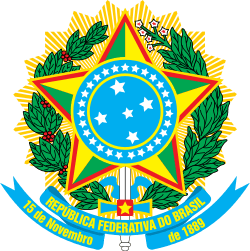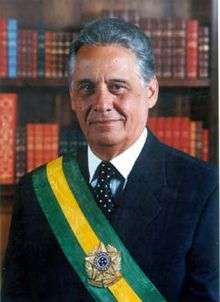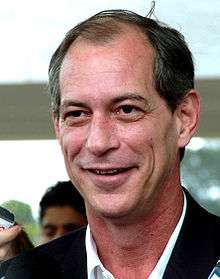Brazilian general election, 1998
| | |||||||||||||||||||||||||||||||||||||||
| |||||||||||||||||||||||||||||||||||||||
| |||||||||||||||||||||||||||||||||||||||
|
| |||||||||||||||||||||||||||||||||||||||
| Presidential election results map after voting: Blue denotes states won by Cardoso Red denotes states won by Lula Orange denotes the state won by Gomes | |||||||||||||||||||||||||||||||||||||||
| |||||||||||||||||||||||||||||||||||||||
 |
| This article is part of a series on the politics and government of Brazil |
|
| Foreign relations |
General elections were held in Brazil on 4 October 1998, with a second round on 25 October.[1] In the first round Fernando Henrique Cardoso was re-elected President and the governorships of 14 states were elected, in addition to all seats in the Chamber of Deputies and Legislative Assemblies, and one third of the seats in the Federal Senate.[2] In the second round the governorships of 12 states and the Federal District were defined.[3] This election was marked by the use of voting machines for the first time ever. They would have been used in all municipalities two years later, in the 2000 local elections.
This was the third general election held after the promulgation of the 1988 Constitution, being also the third time Brazilians voted directly for President since the end of the military dictatorship. Shortly before these elections were held, the federal government was able to approve in the National Congress a constitutional amendment bill allowing the re-election of members of the Executive branch of government. There was much discussion about the constitutionality of the bill,[4] and denouncements were made by the press that some parliamentarians were bribed to vote for the approval of the bill.[5]
Controversies aside, then President Fernando Henrique Cardoso, backed by a coalition that included the three major parties of the time – the Liberal Front Party, the Brazilian Democratic Movement Party (which offered their informal support to him), and his own Brazilian Social Democratic Party – was able to be re-elected in the first round after achieving 53% of the valid votes. His margin over Workers' Party candidate Luiz Inácio Lula da Silva was of 21.3%, giving him a second landslide victory; it is to date the last landslide victory in Brazilian history. Lula da Silva received almost 32% of the votes. Ciro Gomes, then a member of the Socialist People's Party came in third, with almost 11% of the votes.
Historical context
Fernando Henrique Cardoso, better known as FHC, had been inaugurated as President on January 1, 1995, after defeating Luiz Inácio Lula da Silva, his main rival in the 1994 election, in the first round by an advantage of almost 30 million votes.[6] FHC had based his first presidential campaign in the then newly launched Real Plan and the promise of stabilizing the economy of Brazil. As a matter of fact, the plan had a positive effect during the first years of his administration, being able to curb the exorbitant inflation rates, stabilize the exchange rate, and increase the purchasing power of the Brazilian population without shocks or price freezing.[6]
On the very first day of his administration, the Treaty of Asunción came into force.[6] Signed by Fernando Collor de Mello, it predicted the implementation of Mercosur, a free trade area between Brazil, Argentina, Uruguay, and Paraguay.[6] Moreover, the first FHC administration was marked by political and economic reforms, such as the end of the state monopolies in oil and telecommunications, the reform on the social security plans, and the change in the concept of "national company".[6] Although approved in the Congress, the reforms carried by the federal government met strong resistance from the opposition, most notably the Workers' Party, which fiercely criticized the privatization of companies such as Vale do Rio Doce and the constitutional amendment that allowed the re-election of officeholders in the Executive branch.[6] As a result, Peter Mandelson, a close aide to then British Prime Minister and Labour Party leader Tony Blair, stated that the Workers' Party's proposals represented "an old-fashioned and out-of-date socialism".[7] At that time, FHC-Blair relations were magnified, once both of them were adherents of the Third Way.
Despite its political victories, the government needed to impose measures to cool down the domestic demand and help the trade balance, which eventually caused unemployment to grow and made the economy show signs of recession.[6] Other areas, such as health, education and land reform also suffered major crises.[6] The violent conflict in the countryside reached its peak with the Eldorado dos Carajás massacre. Thus, FHC's reelection campaign was based on the idea that the continuity of his government was essential for the stabilization to reach areas other than the economy, such as health, agriculture, employment, education, and public security.[6]
Presidential election
Candidates
The 1998 presidential race had twelve candidates, the largest number of candidates since the 1989 election, when over twenty candidacies were launched. The number could have been as high as fifteen, but the Electoral Justice withdrew the candidacy of impeached President Fernando Collor de Mello,[8] while Oswaldo Souza Oliveira[9] and João Olivar Farias declined to run.
The Brazilian Social Democratic Party reprised the coalition which had elected FHC four years prior, comprising the Liberal Front Party and the Brazilian Labour Party. They were joined by the Progressive Party, the Social Democratic Party, and the Social Liberal Party. Once again, Liberal Front member Marco Maciel was FHC's running mate.
The Workers' Party reprised its past two candidacies, by launching Luiz Inácio Lula da Silva as its candidate and forming a coalition with the Communist Party of Brazil, and the Brazilian Socialist Party. The novelty in this election was the choice of Leonel Brizola from the Democratic Labour Party as his running mate. Prior to that, the Workers' Party refrained from forming coalitions with parties linked to varguista labour unions as a way of sustaining its union branch, the Central Única dos Trabalhadores, as independent. As a result, the United Socialist Workers' Party left the coalition and launched José Maria de Almeida as its candidate.
Former Ceará state Governor Ciro Gomes run for President, and, therefore, his Socialist People's Party did not join the Workers' Party coalition as they did in the previous election. After Oswaldo Souza Oliveira's quit the race, his Party of the Nation's Retirees decided to support Gomes.
After securing the third place in the 1994 election, Enéas Carneiro from the far-right Party of the Reconstruction of the National Order also run in 1998. This time, however, he only received 1.4 million votes, against 4.6 million in 1994.
This election also brought the second woman candidate ever: Thereza Tinajero Ruiz from the National Labour Party, which replaced Dorival Masci de Abreu.[10]
Results
President
| Candidate | Party | Votes | % |
|---|---|---|---|
| Fernando Henrique Cardoso | Brazilian Social Democracy Party | 35,922,692 | 53.1 |
| Luis Inácio Lula da Silva | Workers' Party | 21,470,333 | 31.7 |
| Ciro Gomes | Socialist People's Party | 7,424,783 | 11.0 |
| Enéas Carneiro | Party of the Reconstruction of the National Order | 1,446,783 | 2.1 |
| Ivan Moacyr da Frota | Party of National Mobilization | 251,276 | 0.4 |
| Alfredo Syrkis | Green Party | 212,866 | 0.3 |
| José Maria de Almeida | United Socialist Workers' Party | 202,614 | 0.3 |
| João de Deus Barbosa de Jesus | Labour Party of Brazil | 198,830 | 0.3 |
| José Maria Eymael | Christian Social Democratic Party | 171,814 | 0.3 |
| Thereza Tinajero Ruiz | National Labour Party | 166,053 | 0.2 |
| Sergio Bueno | Social Christian Party | 124,546 | 0.2 |
| Vasco Azevedo Neto | National Solidarity Party | 108,969 | 0.2 |
| Invalid/blank votes | 15,971,978 | – | |
| Total | 83,673,537 | 100 | |
| Registered voters/turnout | 106,053,106 | 78.9 | |
| Source: Nohlen[11] | |||
Chamber of Deputies
Senate
References
- ↑ UOL nas eleições. Retrieved 2010-12-02.
- ↑ First round results. UOL nas eleições. Retrieved 2010-12-02.
- ↑ Second round results. UOL nas eleições. Retrieved 2010-12-02.
- ↑ MACHADO, Ivan. "Inconstitucionalidade da emenda da reeleição" Archived December 23, 2009, at the Wayback Machine.. Jus Navigandi. Teresina, N° 21, Nov. 1997. Accessed December 2, 2010.
- ↑ RODRIGUES, Fernando. ["Deputado diz que vendeu seu voto a favor da reeleição por R$ 200 mil"]. Folha de S.Paulo. May 13, 1997. Accessed December 2, 2010.
- 1 2 3 4 5 6 7 8 9 MASON, Anthony. Memórias do Século XX - Vol. 6: Tempos Modernos, 1970-1999. Translated and adapted by Maria Clara de Mello Motta. Rio de Janeiro: Reader's Digest, 2004. ISBN 85-7645-016-X
- ↑ "Mandelson under fire in Brazil". BBC News. 1998-07-23. Retrieved 2010-11-01.
- ↑ "O Caso Collor - A tentativa de retorno" Archived June 9, 2009, at the Wayback Machine.. Supreme Electoral Court. December 19, 2008. Accessed December 2, 2010.
- ↑ MENEZES, Ana Cláudia. "Candidatos passam o Dia dos Pais com as famílias". A Notícia. August 10, 1998. Accessed December 2, 2010.
- ↑ LARANJEIRA, Leandro. "Mulheres podem fazer história nas eleições de 2010". Diário do Grande ABC. 10 de agosto de 2009. Acesso em: 28 de junho de 2010.
- ↑ Nohlen, D (2005) Elections in the Americas: A data handbook, Volume II, p234 ISBN 978-0-19-928358-3
- ↑ Nohlen, D (2005) Elections in the Americas: A data handbook, Volume II, pp196-226 ISBN 978-0-19-928358-3
- ↑ Nohlen, D (2005) Elections in the Americas: A data handbook, Volume II, p213 ISBN 978-0-19-928358-3
External links
- 1998 Brazilian general election results at the Supreme Electoral Court official website



.svg.png)